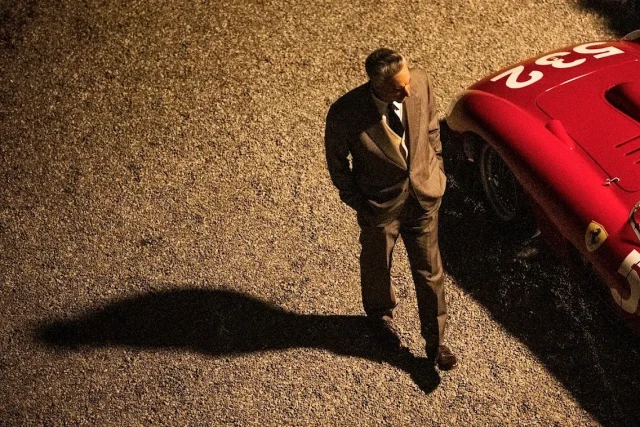
Enzo Ferrari wants to win. Before he was the founder of the Italian luxury car manufacturer Ferrari S.p.A. and the similarly named Grand Prix racing team, Ferrari was a driver. But with the birth of his first son, Dino, he hung up his gloves and turned his attention to building race cars.
Of course, racing is a costly endeavor, and when Ferrari — directed by Michael Mann from a screenplay by Troy Kennedy Martin based on Brock Yates’ nonfiction book — picks up the automobile impresario’s story in 1957, the company is going under. The Scuderia Ferrari Grand Prix motor racing team hasn’t won a race in a while and is losing the custom-built car business to Jaguar. “He races to sell cars,” Ferrari says of his English competitor. “I sell cars to race.”
Adam Driver plays Ferrari with slicked-back white hair, ever-present black sunglasses and a well-fed man’s paunch. Driver is excellent. So is Penélope Cruz, who plays Laura Ferrari, and the multitude of actors playing the staff at the factory and Ferrari’s bullpen of drivers, particularly Alfonso De Portago (Gabriel Leone) and Piero Taruffi (Patrick Dempsey). Ferrari is the grown-up version of The House of Gucci — no ridiculous accents or garish costumes that feel like mockery. Instead, Mann and his team aim for electricity and tension. In one scene, Ferrari confronts his drivers with a speech so controlled, so calm, so captivating you’ll want to watch it twice.
Performances aside, the real draw here is the racing, and Mann does not disappoint. Cinematographer Erik Messerschmidt and editor Pietro Scalia blend long shots, quick cuts, dolly-zooms — you name it — to create the rush of racing through city streets and down country roads within inches of ecstatic spectators. It’s a dangerous profession, and the loss of past drivers haunts Ferrari and everyone who climbs behind the wheel, not to mention those they’ve loved. But the drivers know what they are getting into. Not that it takes the sting off anything, least of all the startling and horrific accident that expertly pulls viewers out of Ferrari’s thrills and grounds it into history.
And while the racing and driving here is the fun of Ferrari — Mann and Scalia delightfully tease the movie’s energy in an early moment of Ferrari expertly shifting gears while driving home to his wife — the real hook of the narrative is the relationships. Laura loathes her husband and blames him for the death of their son, Dino. Theirs is not a happy marriage. Ferrari moved on years ago when he met his mistress Lina (Shailene Woodley) during the war and sired another son. He could have left Laura years ago, but she owns half of the company’s stock, and Ferrari needs her to grant him power of attorney so he can negotiate a buyout with either Ford or Fiat.
But their relationship is more than paper. Laura and Ferrari know each other and need each other. At one point, Laura fires a pistol at Ferrari and hits the wall next to his head. When Ferrari later recounts the incident to Dino’s tomb, he says, “Your mother missed on purpose. Someday she won’t.”
Ferrari is loaded with such moments — like the start of the 1957 Mille Miglia. Here, Ferrari speaks to his five drivers separately, explaining to each one why they are a better driver than the others and why their car is capable of winning the race. They all believe what Ferrari tells them because Ferrari believes it. And thanks to Driver’s performance, you will too.
ON SCREEN: Ferrari opens in wide release on Dec. 25.














